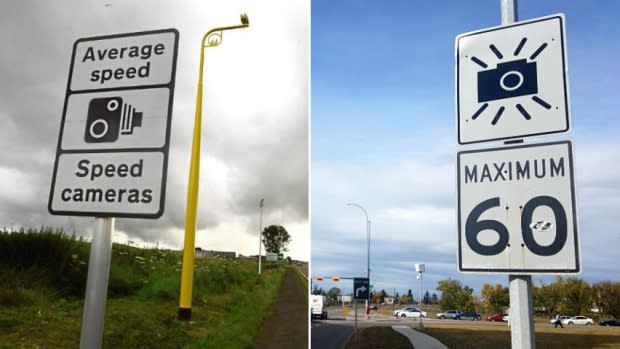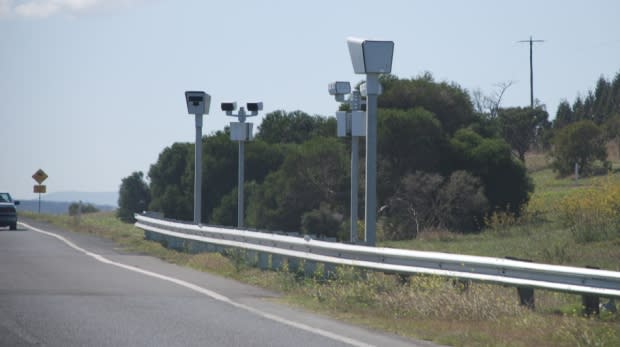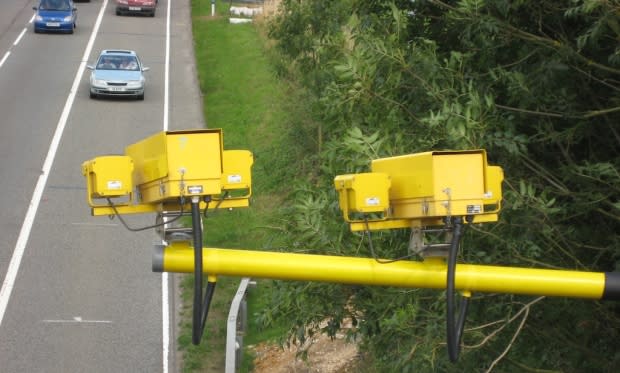Average-speed cameras: The 'evil invention' seen as a 'silver bullet' against speeding

By now, Albertans are familiar with photo radar — and how to avoid it.
As long as you spot the camera soon enough, you can simply slow down as you pass by, then speed back up again.
But there's another type of automated enforcement that can't be defeated in the same way.
To road-safety advocates, they're a "silver bullet" in the fight against speeding. To lead-footed drivers, they're "one of the most evil inventions of recent time."
They're known as average-speed cameras.
And they could be coming soon to a street near you.
How they work
Average-speed cameras are common across Europe and Australia but many North Americans have never heard of them.
Unlike photo radar, the devices don't measure a driver's speed at a single point in time. Instead, they work in pairs to track a vehicle over a greater distance — several kilometres, often — and then calculate its travel time from Point A to Point B.
From there, it's just a matter of applying a high-school physics formula:
Average speed = total distance travelled ÷ total time travelling
It doesn't matter how fast you're going when you pass by the first camera, or how fast you're going when you pass by the second camera. If your average speed over the stretch of roadway in between the cameras exceeds the speed limit, you get a ticket in the mail.
So far, average-speed cameras are nowhere to be found in Canada.
But they've been creeping into the conversation.
Drivers dread it, politicians are intrigued
There have been quiet rumblings about average-speed cameras among Canadian drivers who are familiar with how hard they are to avoid. Some are dreading the day they make their way to this country.
"I think average speed cameras are in our future," wrote one person in a discussion of Alberta highways on a popular driving forum.
"Oh dear lord I hope not," replied another.
"These have to be one of the most evil inventions of recent time," wrote an American travel blogger who encountered the devices in the U.K. "There is no escaping them."
Some politicians, meanwhile, are starting to see the devices' potential as an enforcement tool.
Earlier this year, a pair of mayors in British Columbia called on the B.C. government to adopt average-speed cameras along the Sea to Sky Highway, as a way to curb speeding through their towns. A Calgary city councillor now says she's intrigued by the technology, as well.
Werner Antweiler, a professor at UBC's Sauder School of Business, believes the devices will make their way to North America.
"As this technology is getting cheaper, expect such systems to appear in Canada and the United States," he wrote in a blog post.
And, if the goal is to reduce speeding, there's ample evidence the devices work.
Take Scotland, for example.
Reduction in speeding 'really quite incredible'
Drivers in Scotland might not love average speed cameras, but Scottish officials say it's hard to argue with their results.
The devices were first put up in 2005 along the A77, a major highway that runs from Glasgow to the town of Portpatrick on the Irish Sea. It's a winding route that starts off twinned but narrows to two-way traffic at the southern end. (Think Highway 22 between Calgary and Pincher Creek.)
The A77 was once named among the 25 most dangerous roads in the world. Between 1996 and 2005, the route saw 30 people killed in crashes and nearly 250 more seriously injured.

After average-speed cameras were installed, however, the number of fatalities and serious injuries on the route declined by 74 per cent, according to the Scottish government.
"The impact of them is really quite incredible," said Humza Yousaf, then Scottish Minister of Transport, in an interview with CBC British Columbia in February.
Similar results were seen on another major highway in Scotland, the A90.
A traffic survey found 60 per cent vehicles on the route were speeding prior to the installation of average-speed cameras. That fell to just one per cent after the devices took effect.
"People in Scotland now very much accept that they work," Yousaf said.
It's not surprising, then, that they're being installed in more and more places.
A 'silver bullet'
The first trials of average-speed cameras took place in the Netherlands in 1997 and they later spread across Europe.
In the U.K, they've become increasingly common, since the first devices were installed in the English county of Nottinghamshire in 2000. By 2015, average-speed cameras covered 410 kilometres of roadway. (And that doesn't include mobile versions of the devices, which are sometimes deployed in construction zones.)
The technology is in use in Australia, as well, where it's known as "point-to-point" enforcement.

Canadians who are curious about the devices should know they have proven remarkably effective at reducing speeding, says Ian Faulks with the Centre for Accident Research and Road Safety at the Queensland University of Technology.
"My view is that point-to-point speed cameras are one of those rare examples of a 'silver bullet' to address illegal driving behaviours," he said, in an email interview.
The devices can operate 24 hours a day, using infrared illumination at night to read licence plates. They can be deployed as little as 200 metres apart or span dozens of kilometres.
Popular reaction has been mixed, however.
'Yellow vultures'
British drivers have a nickname for the brightly coloured average-speed cameras that loom over their highways.
"Yellow vultures."
Drivers in the U.K. have also complained about receiving tickets for travelling only a few kilometres per hour over the posted limit, although that's a local law-enforcement decision, not a function of the cameras, themselves.

In Australia, some of the devices were recently pulled offline after inaccurate speed readings were detected, and police undertook a review of tens of thousands of fines that had been previously handed out.
While they have their critics, Faulks says average-speed cameras are also regarded in Australia "as being a very fair way to detect speeding drivers."
Because they target "sustained speeding," he said, they're less likely to catch people who momentarily speed up to overtake another vehicle or accidentally exceed the speed limit while driving down a hill.
And that issue — fairness — has been a point of contention with photo radar in Alberta.
Photo radar review
Some drivers have accused police of setting up photo-radar devices where they're likely to catch people momentarily speeding down hills, or where the speed limit suddenly changes, rather than in locations where speeding is a genuine problem.
The criticisms prompted the provincial government to launch a review of photo radar last year.
"My concern is that there's a strong public view that photo radar has gone beyond just enforcing safe traffic and has become, in some cases, a bit of a 'cash cow' for municipalities," Transportation Minister Brian Mason said in May 2017.

Alberta Transportation says the photo-radar review is ongoing but it does not include any examination of average-speed cameras as an alternative.
But Coun. Druh Farrell, an advocate for reduced residential speed limits in Calgary, says she's interested in how average-speed cameras might be used within the city.
"It sounds like an excellent tool and we really need every tool available to ensure that we have safer streets," she said.
The province says the technology is not yet approved for use, however, and the Automated Traffic Enforcement Technology Guidelines would need to be amended before any municipalities could start installing them.
So, while the use of average-speed cameras continues to grow in other parts of the world, they remain just an idea in Alberta — for now.
Calgary: The Road Ahead is CBC Calgary's special focus on our city as it passes through the crucible of the downturn: the challenges we face, and the possible solutions as we explore what kind of Calgary we want to create. This story is part of a sub-series on roads and how they shape our lives. Have an idea for a future story? Email us: calgarytheroadahead@cbc.ca
More from the Roads sub-series:
Other stories from the series:

